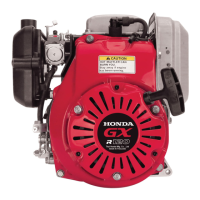
Do you have a question about the Honda GXR120T and is the answer not in the manual?
| Displacement | 118 cc |
|---|---|
| Compression Ratio | 8.5:1 |
| Fuel System | Carburetor |
| Ignition System | Transistorized magneto ignition |
| Oil Capacity | 0.6 L |
| Starting System | Recoil starter |
| Engine Type | 4-stroke, single cylinder |
| Cooling System | Forced air |
| Valve Train | OHV (Overhead Valve) |
| Net Power Output | 3.6 HP (2.7 kW) at 3, 600 rpm |
| Lubrication System | Forced splash |
Identifies the location of model and engine serial numbers for inquiries.
Details engine configurations and model types in a tabular format.
Provides physical measurements and weight data for various engine models.
Lists technical data including displacement, power, torque, and fuel consumption.
Graphical data showing net torque and net power relative to engine speed.
Illustrates engine dimensions with key measurements.
Presents detailed diagrams and measurements for Power Take-Off shafts.
Lists specific measurements, clearances, and operational limits for engine parts.
Specifies recommended torque values for fasteners and various components.
Identifies locations requiring lubrication and sealing during maintenance procedures.
Lists and illustrates the special tools necessary for engine servicing.
Diagrams guide correct installation paths for electrical harnesses and fuel lines.
Lists tools specifically required for performing maintenance tasks.
Outlines recommended intervals for checking and servicing engine components.
Details the procedure for checking, adding, and changing engine oil.
Covers inspection, cleaning, and replacement of the air filter element.
Provides guidance for inspecting, gapping, and adjusting the spark plug.
Describes how to check the timing belt for wear or damage.
Explains how to set and adjust the engine's idle speed correctly.
Method for removing carbon deposits from the combustion chamber.
Step-by-step guide for checking and adjusting valve clearances.
Essential initial checks and considerations before diagnosing engine problems.
Diagnostic steps for issues preventing the engine from turning over.
Troubleshooting procedures for engines that rotate but do not ignite.
Diagnoses problems related to unstable or insufficient engine speed.
Troubleshoots failures of the engine stopping mechanism related to the stop switch.
Troubleshoots failures of the engine stopping mechanism due to low oil level.
Guidance on interpreting wiring diagrams, connectors, and system symbols.
Presents detailed schematics of the engine's electrical circuits.
